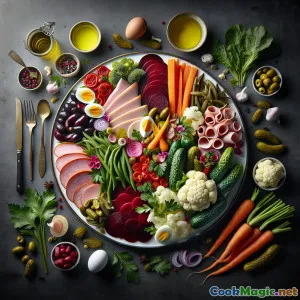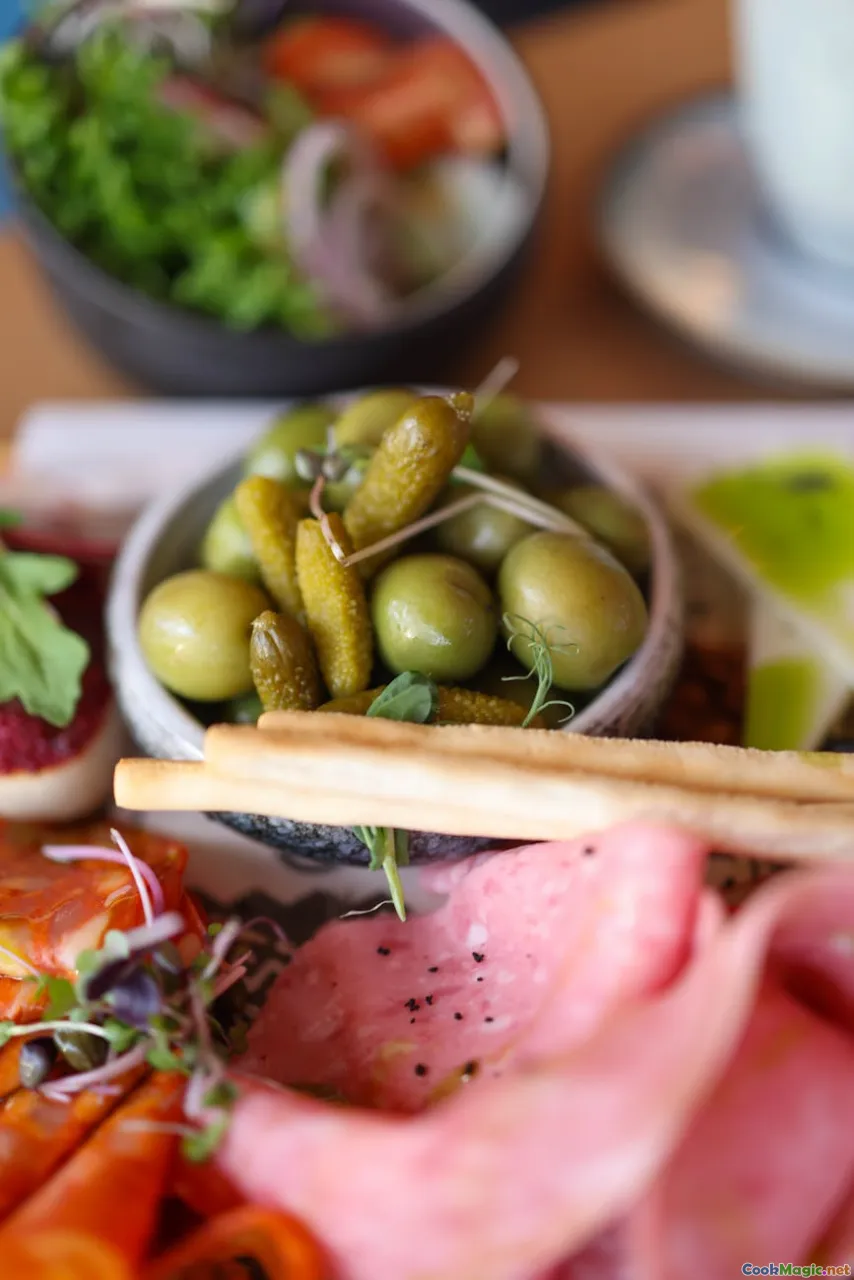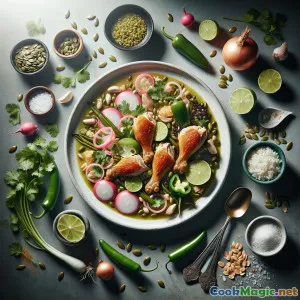
为万圣节准备的彩色危地马拉火腿
(Colorful Guatemalan Fiambre for All Saints Day)
(0 评论)食材
-
200 grams 切片熟制甜菜根
(红色或金色甜菜,煮熟后冷却)
-
150 grams 煮胡萝卜
(切片)
-
120 grams 青豆
(修整后焯水)
-
120 grams 菜花小花
(刚好变脆的预煮)
-
250 grams 鸡胸肉
(水煮、冷却后撕碎)
-
200 grams 火腿
(切成薄条)
-
100 grams 意大利腊肠
(切得很薄)
-
80 grams 西班牙辣香肠
(切成圆片)
-
100 grams 腌制奶酪(queso fresco)
(切成立方体)
-
50 grams 腌制婴儿玉米
-
60 grams 腌制洋葱
-
80 grams 泡菜黄瓜
(切片)
-
80 grams 青橄榄
(去核)
-
80 grams 黑橄榄
(去核)
-
4 large 鸡蛋
(全熟鸡蛋,切成四块)
-
1 bunch 香菜
(用作装饰的切碎新鲜香草)
-
1 head 生菜叶
(清洗后完整)
-
200 ml 油醋汁
(橄榄油、醋、一点危地马拉芥末、黑胡椒和牛至的混合)
-
2 tbsp 刺山柑
(沥干并冲洗)
-
3 medium 萝卜
(用于装饰的薄切)
(红色或金色甜菜,煮熟后冷却)
(切片)
(修整后焯水)
(刚好变脆的预煮)
(水煮、冷却后撕碎)
(切成薄条)
(切得很薄)
(切成圆片)
(切成立方体)
(切片)
(去核)
(去核)
(全熟鸡蛋,切成四块)
(用作装饰的切碎新鲜香草)
(清洗后完整)
(橄榄油、醋、一点危地马拉芥末、黑胡椒和牛至的混合)
(沥干并冲洗)
(用于装饰的薄切)
营养
- 份量: 10
- 每份大小: 1份丰盛的盘子(350g)
- Calories: 360 kcal
- Carbohydrates: 19 g
- Protein: 22 g
- Fat: 19 g
- Fiber: 5 g
- Sugar: 6 g
- Sodium: 885 mg
- Cholesterol: 206 mg
- Calcium: 160 mg
- Iron: 2.7 mg
制作步骤
-
1 - 准备蔬菜和肉类:
去皮并煮熟甜菜、胡萝卜、青豆和花椰菜。充分冷却。必要时煮熟并切碎鸡胸肉、火腿和辣香肠。将所有肉类和奶酪切成薄片或方块备用,以便拼盘。
-
2 - 排列组件组:
在一个大盘或多个盘子上,将生菜叶作为底层。将配料整齐地叠放成一束,比如甜菜、泡菜拼盘、拼装的肉类,然后放上奶酪,形成鲜明的条纹。
-
3 - 加入鸡蛋和装饰蔬菜:
将煮熟的鸡蛋切成四份并摆放在沙拉上。加入萝卜片、腌洋葱、玉米,用橄榄和刺山柑点缀,增添色彩和风味。
-
4 - 淋上油醋汁:
将橄榄油、醋、芥末、胡椒和牛至混合在一起。轻轻地淋在沙拉上,确保每组蔬菜、奶酪和肉类都被均匀地覆盖。让味道在冰箱中静置至少1小时,盖好。
-
5 - 装饰和上菜:
在上菜前,撒上切碎的新鲜香菜。从大盘直接上菜,确保每个盘子都包含具有代表性的风味和质地的截面。
去皮并煮熟甜菜、胡萝卜、青豆和花椰菜。充分冷却。必要时煮熟并切碎鸡胸肉、火腿和辣香肠。将所有肉类和奶酪切成薄片或方块备用,以便拼盘。
在一个大盘或多个盘子上,将生菜叶作为底层。将配料整齐地叠放成一束,比如甜菜、泡菜拼盘、拼装的肉类,然后放上奶酪,形成鲜明的条纹。
将煮熟的鸡蛋切成四份并摆放在沙拉上。加入萝卜片、腌洋葱、玉米,用橄榄和刺山柑点缀,增添色彩和风味。
将橄榄油、醋、芥末、胡椒和牛至混合在一起。轻轻地淋在沙拉上,确保每组蔬菜、奶酪和肉类都被均匀地覆盖。让味道在冰箱中静置至少1小时,盖好。
在上菜前,撒上切碎的新鲜香菜。从大盘直接上菜,确保每个盘子都包含具有代表性的风味和质地的截面。
关于 为万圣节准备的彩色危地马拉火腿 :的更多信息
The Story and Spirit Behind Guatemalan Fiambre Tradicional del 1 de Noviembre
If you've ever visited Guatemala during October’s end, you may encounter the dizzying scent of pickles, the tapestry-like color flashes of beets, peppers, green beans and eggs, all arranged magisterially onto platters that seem ablaze with edible confetti. This is Fiambre Tradicional del 1 de Noviembre—perhaps Guatemala’s most iconic cold salad and an appetizer, main dish, and centerpiece of memory-making all in one. It is joy, remembrance, unity, and family—flavors threaded across generations and afterlives.
Historical and Cultural Significance
Fiambre isn’t merely food. It’s a living quilt. This recipe has its roots deeply planted in colonial times with precedent in Spanish and Moorish antipasto. Over centuries, swept up through generations of Catholic influence and indigenous rituals honoring the dead, it emerged as Guatemala's commemorative Table of the Dead feast for Día de Todos los Santos (All Saints' Day, November 1st). Each family tweaks its own Fiambre recipe—an edible act of homage. Ingredients are selected not just for taste, but for their symbolic ties to deceased relatives: some meats for toughness (strength), eggs for life, and so on. Preparing Fiambre is a matter for consultation amongst ancestors—no two salads are ever truly the same from house to house or year to year.
Fiambre’s Unique Aspects
What sets Fiambre apart from anything you’ve tasted? It’s the sheer variety and balance. Cold, reserved vegetables (beets, cauliflower, carrots, beans, corn), prepared ahead and chilled, are an aromatic rainbow among finely sliced chorizo, salami, chicken, ham, and cheese. These are united with marinated vegetables like baby corn, capers, and myriad olives listed by the handful. Its vinaigrette, suffused with vinegar, smooth olive oil, Guatemalan mustard, oregano, sometimes even a trace of that family’s secret spice, soaks into the entire dish, marrying tang with the cooling mouthfeel and textural surprises.
After marinating, chilled for at least an hour, the dish is presented whole—a wild geometric layering of ingredients. Guests are served so each plate receives meat, veg, cheese, and garnish, welcoming all assembled and remembered. Some regions add seafood (fiambre rojo), while vegetarian takes exist (fiambre verde). Feel free to substitute local charcuterie or vegetarian sausages.
Preparing Fiambre at Home
Making fiambre is a task best done ahead—and even better as a collective event with family. Slice, cube, and allocate your components so that on an expansive platter, there’s visual order and balance: the slide of shining red beetroots laid against slices of pink ham, crisp florets of white cauliflower beside chartreuse gherkins, bright yellow pickled corn standing upright. Hard boiled eggs intersperse for softness, cheeses alternate for boldness. Set it all off with green herbs and savory vinaigrette.
It’s customary and practical to marinate the completed platter for an hour or more, giving flavors time to develop. Some even assemble it on October 31st, providing plenty of time for every meat and pickle to express its personality.
Serving and Personal Reflection
As a chef, few things are more gratifying than serving fiambre. The gasps from first-timers who marvel at the color story, followed by their beaming faces after the first bite—a taste surprising silky, bold, tart, sweet, deeply savory—illustrate its magic. Fiambre morphs the very idea of salad from a side act to main event; every version is a fingerprint for a family.
Beyond flavor, preparing fiambre brings people together: each person engaged at the table offers more than another set of hands—they put forward decades of memory and affection for those absent and present. It deepens one's respect for ancestors and celebrates identity—culinary, familial, and national. If you want to host a tradition that's intensely personal yet simultaneously inclusive, carve out a night this autumn for Fiambre.
Tips & Notes
- Advance preparation and refrigeration are key. Flavors improve overnight.
- Use a blend of fresh and pickled vegetables for authentic texture play.
- Don’t over-saturate with vinaigrette—drizzle lightly and allow guests to add their own.
- Arrange leftovers in jars—fiambre keeps well for days and develops increasingly complex flavors.
Honor, flavor, vivid memories, and the colors of life: that’s what awaits you in every bite of Fiambre Tradicional del 1 de Noviembre.
























